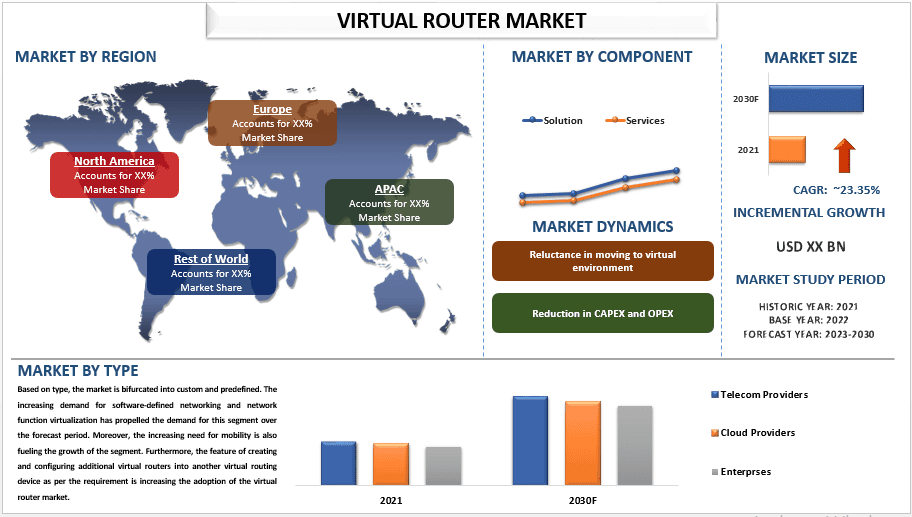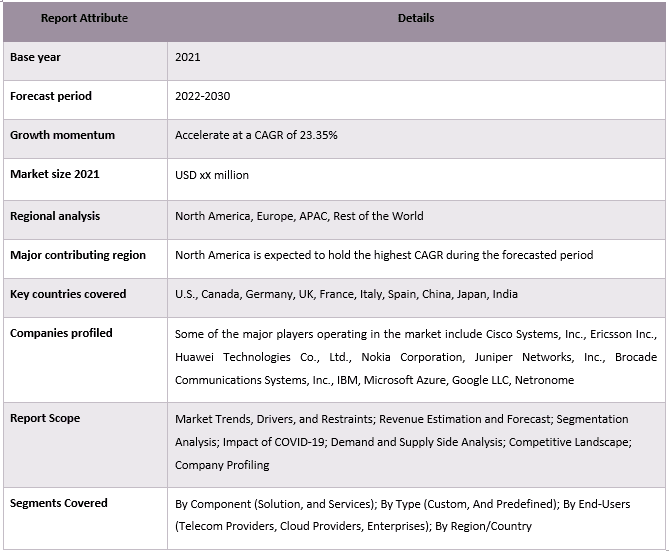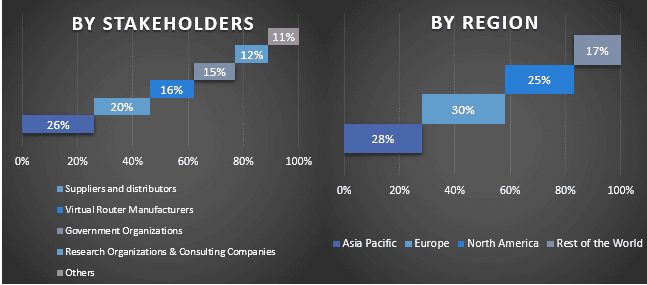- Trang chủ
- Về chúng tôi
- Ngành
- Dịch vụ
- Đọc
- Liên hệ với chúng tôi
Thị trường Bộ định tuyến Ảo: Phân tích Hiện tại và Dự báo (2022-2030)
Nhấn mạnh vào Thành phần (Giải pháp và Dịch vụ); Loại (Tùy chỉnh và Được xác định trước); Người dùng cuối (Nhà cung cấp dịch vụ viễn thông, Nhà cung cấp dịch vụ đám mây, Doanh nghiệp); Khu vực/Quốc gia.

Thị trường Bộ Định Tuyến Ảo dự kiến sẽ tăng trưởng với tốc độ CAGR mạnh mẽ là 23,35% trong giai đoạn dự báo do nhu cầu cải thiện tính linh hoạt và hiệu quả của mạng trên toàn cầu ngày càng tăng. Bộ định tuyến ảo là một khuôn khổ định tuyến dựa trên phần mềm, cho phép máy chủ hoạt động như một bộ định tuyến phần cứng truyền thống trên mạng cục bộ. Bộ định tuyến ảo tiết kiệm chi phí hơn so với bộ định tuyến vật lý. Hơn nữa, chúng dễ dàng và nhanh chóng thiết lập. Ngoài ra, chúng không yêu cầu truy cập vật lý vào bộ định tuyến để dễ dàng định cấu hình hoặc cập nhật từ xa. Thứ hai, bộ chuyển mạch ảo có khả năng thích ứng cao hơn so với bộ chuyển mạch thiết bị thông thường. Hơn nữa, sự gia tăng nhu cầu đối với các yêu cầu như các giải pháp mạng đám mây linh hoạt, có khả năng mở rộng, hiệu quả và tiết kiệm chi phí cùng với các giải pháp bộ định tuyến ảo đang thúc đẩy thị trường.
Một số nhà sản xuất lớn hoạt động trên thị trường bao gồm Cisco Systems, Inc., Ericsson Inc., Huawei Technologies Co., Ltd., Nokia Corporation, Juniper Networks, Inc., Brocade Communications Systems, Inc., IBM, Microsoft Azure, Google LLC, Netronome.
Thông tin chi tiết được trình bày trong báo cáo
“Trong số các thành phần, phân khúc giải pháp chiếm một thị phần đáng kể của thị trường trong giai đoạn dự báo.”
Dựa trên các thành phần, thị trường được chia thành giải pháp và dịch vụ. Trong số này, phân khúc giải pháp chiếm thị phần cao nhất trên thị trường vì nó cung cấp nhiều giải pháp và ưu đãi khác nhau cho người tiêu dùng. Ví dụ: Bộ định tuyến ảo dựa trên phần mềm chạy trên máy ảo hoặc nền tảng đám mây và cung cấp chức năng định tuyến thông qua phần mềm. Chúng mang lại sự linh hoạt, khả năng mở rộng và hiệu quả chi phí so với bộ định tuyến phần cứng truyền thống. Các giải pháp này có thể được triển khai trong trung tâm dữ liệu, môi trường đám mây hoặc mạng biên.
“Trong số các loại, phân khúc tùy chỉnh chiếm phần lớn thị phần của thị trường Bộ định tuyến ảo vào năm 2021.”
Dựa trên loại, thị trường được chia thành tùy chỉnh và xác định trước và trong số này, các phân khúc tùy chỉnh chiếm một thị phần đáng kể trên thị trường. Bộ định tuyến ảo loại tùy chỉnh đề cập đến các giải pháp bộ định tuyến ảo được thiết kế riêng hoặc tùy chỉnh để đáp ứng các yêu cầu riêng của từng tổ chức hoặc khách hàng. Mặc dù không có phân khúc thị trường cụ thể nào dành riêng cho bộ định tuyến ảo loại tùy chỉnh, nhưng vẫn có nhu cầu tùy chỉnh trên thị trường bộ định tuyến ảo.
“Bắc Mỹ chiếm thị phần lớn nhất của Thị trường Bộ định tuyến ảo vào năm 2021.”
Các doanh nghiệp Bắc Mỹ đã tích cực áp dụng chuyển đổi kỹ thuật số để nâng cao khả năng cạnh tranh và hiệu quả của họ. Bộ định tuyến ảo cung cấp một giải pháp mạng linh hoạt và có khả năng mở rộng, phù hợp với nhu cầu ngày càng phát triển của các tổ chức này. Khi các doanh nghiệp áp dụng điện toán đám mây, mạng được xác định bằng phần mềm và các chức năng mạng ảo hóa, nhu cầu về bộ định tuyến ảo ngày càng tăng. Hơn nữa, khu vực Bắc Mỹ đã đi đầu trong việc áp dụng đám mây, với một số lượng đáng kể các doanh nghiệp tận dụng môi trường đám mây công cộng, riêng tư và kết hợp. Bộ định tuyến ảo đóng một vai trò quan trọng trong việc cho phép kết nối giữa mạng tại chỗ và đám mây. Chúng tạo điều kiện thuận lợi cho việc truyền dữ liệu an toàn và hiệu quả, định tuyến và tích hợp giữa các tài nguyên đám mây khác nhau và mạng doanh nghiệp.
Phạm Vi Báo Cáo Thị Trường Bộ Định Tuyến Ảo

Lý do nên mua báo cáo này:
- Nghiên cứu bao gồm phân tích quy mô thị trường và dự báo được xác thực bởi các chuyên gia hàng đầu trong ngành.
- Báo cáo trình bày một đánh giá nhanh về hiệu suất tổng thể của ngành trong nháy mắt.
- Báo cáo bao gồm phân tích chuyên sâu về các đối thủ cạnh tranh nổi bật trong ngành, tập trung chủ yếu vào tình hình tài chính kinh doanh quan trọng, danh mục sản phẩm, chiến lược mở rộng và các phát triển gần đây.
- Kiểm tra chi tiết các động lực, hạn chế, xu hướng chính và cơ hội hiện hành trong ngành.
- Nghiên cứu bao quát toàn diện thị trường trên các phân khúc khác nhau.
- Phân tích sâu ở cấp độ khu vực của ngành.
Tùy chọn tùy chỉnh:
Thị trường Bộ định tuyến ảo toàn cầu có thể được tùy chỉnh thêm theo yêu cầu hoặc bất kỳ phân khúc thị trường nào khác. Bên cạnh đó, UMI hiểu rằng bạn có thể có nhu cầu kinh doanh riêng, vì vậy hãy liên hệ với chúng tôi để có được một báo cáo hoàn toàn phù hợp với yêu cầu của bạn.
Mục lục
Phương Pháp Nghiên Cứu Phân Tích Thị Trường Bộ Định Tuyến Ảo (2022-2030)
Phân tích thị trường lịch sử, ước tính thị trường hiện tại và dự báo thị trường tương lai của thị trường Bộ Định Tuyến Ảo toàn cầu là ba bước chính được thực hiện để tạo và phân tích việc áp dụng Bộ Định Tuyến Ảo ở các khu vực lớn trên toàn cầu. Nghiên cứu thứ cấp toàn diện đã được tiến hành để thu thập các số liệu thị trường lịch sử và ước tính quy mô thị trường hiện tại. Thứ hai, để xác thực những hiểu biết này, nhiều phát hiện và giả định đã được xem xét. Hơn nữa, các cuộc phỏng vấn sơ cấp toàn diện cũng được thực hiện, với các chuyên gia trong ngành trên toàn bộ chuỗi giá trị của thị trường Bộ Định Tuyến Ảo toàn cầu. Sau khi giả định và xác thực các số liệu thị trường thông qua các cuộc phỏng vấn sơ cấp, chúng tôi đã sử dụng phương pháp tiếp cận từ trên xuống/từ dưới lên để dự báo quy mô thị trường hoàn chỉnh. Sau đó, các phương pháp phân tích thị trường và phân tích dữ liệu ba bên đã được áp dụng để ước tính và phân tích quy mô thị trường của các phân khúc và phân khúc phụ của ngành có liên quan. Phương pháp chi tiết được giải thích dưới đây:
Phân Tích Quy Mô Thị Trường Lịch Sử
Bước 1: Nghiên Cứu Chuyên Sâu Các Nguồn Thứ Cấp:
Nghiên cứu thứ cấp chi tiết đã được thực hiện để thu thập quy mô thị trường lịch sử của thị trường Bộ Định Tuyến Ảo thông qua các nguồn nội bộ của công ty như báo cáo thường niên & báo cáo tài chính, thuyết trình hiệu suất, thông cáo báo chí, v.v., và các nguồn bên ngoài bao gồm tạp chí, tin tức & bài viết, ấn phẩm của chính phủ, ấn phẩm của đối thủ cạnh tranh, báo cáo ngành, cơ sở dữ liệu của bên thứ ba và các ấn phẩm đáng tin cậy khác.
Bước 2: Phân Khúc Thị Trường:
Sau khi thu thập quy mô thị trường lịch sử của thị trường Bộ Định Tuyến Ảo, chúng tôi đã tiến hành phân tích thứ cấp chi tiết để thu thập thông tin chi tiết về thị trường lịch sử và chia sẻ cho các phân khúc & phân khúc phụ khác nhau cho các khu vực lớn. Các phân khúc chính được bao gồm trong báo cáo là thành phần, loại và người dùng cuối. Các phân tích cấp quốc gia sâu hơn đã được thực hiện để đánh giá việc áp dụng tổng thể các mô hình thử nghiệm trong khu vực đó.
Bước 3: Phân Tích Yếu Tố:
Sau khi thu thập quy mô thị trường lịch sử của các phân khúc và phân khúc phụ khác nhau, chúng tôi đã tiến hành phân tích yếu tố chi tiết để ước tính quy mô thị trường hiện tại của thị trường Bộ Định Tuyến Ảo. Hơn nữa, chúng tôi đã tiến hành phân tích yếu tố bằng cách sử dụng các biến phụ thuộc và độc lập như thành phần, phương thức phát triển, loại bảo mật, các cuộc tấn công Bộ Định Tuyến Ảo và loại ngành. Một phân tích kỹ lưỡng đã được thực hiện về các kịch bản cung và cầu có xem xét các quan hệ đối tác hàng đầu, sáp nhập và mua lại, mở rộng kinh doanh và ra mắt sản phẩm trong lĩnh vực thị trường Bộ Định Tuyến Ảo trên toàn cầu.
Ước Tính & Dự Báo Quy Mô Thị Trường Hiện Tại
Xác Định Quy Mô Thị Trường Hiện Tại: Dựa trên những hiểu biết sâu sắc có thể hành động từ 3 bước trên, chúng tôi đã đưa ra quy mô thị trường hiện tại, những người chơi chủ chốt trong thị trường Bộ Định Tuyến Ảo toàn cầu và thị phần của các phân khúc. Tất cả các phần trăm chia sẻ, phân chia và phân tích thị trường cần thiết đã được xác định bằng cách sử dụng phương pháp thứ cấp đã đề cập ở trên và được xác minh thông qua các cuộc phỏng vấn sơ cấp.
Ước Tính & Dự Báo: Để ước tính và dự báo thị trường, trọng số đã được gán cho các yếu tố khác nhau bao gồm động lực & xu hướng, hạn chế và cơ hội có sẵn cho các bên liên quan. Sau khi phân tích các yếu tố này, các kỹ thuật dự báo có liên quan, tức là phương pháp tiếp cận từ trên xuống/từ dưới lên đã được áp dụng để đưa ra dự báo thị trường cho năm 2030 cho các phân khúc và phân khúc phụ khác nhau trên các thị trường lớn trên toàn cầu. Phương pháp nghiên cứu được áp dụng để ước tính quy mô thị trường bao gồm:
- Quy mô thị trường của ngành, về doanh thu (USD) và tỷ lệ chấp nhận của thị trường Bộ Định Tuyến Ảo trên các thị trường lớn trong nước
- Tất cả các phần trăm chia sẻ, phân chia và phân tích của các phân khúc và phân khúc phụ thị trường.
- Những người chơi chủ chốt trong thị trường Bộ Định Tuyến Ảo toàn cầu về các sản phẩm được cung cấp. Ngoài ra, các chiến lược tăng trưởng được các nhà cung cấp này áp dụng để cạnh tranh trong thị trường đang phát triển nhanh chóng.
Xác Thực Quy Mô và Thị Phần Thị Trường
Nghiên Cứu Sơ Cấp: Các cuộc phỏng vấn chuyên sâu đã được thực hiện với các Nhà Lãnh Đạo Quan Điểm Chủ Chốt (KOLs) bao gồm các Giám Đốc Điều Hành Cấp Cao (CXO/Phó Chủ Tịch, Trưởng Phòng Bán Hàng, Trưởng Phòng Marketing, Trưởng Phòng Điều Hành, Trưởng Phòng Khu Vực, Trưởng Phòng Quốc Gia, v.v.) trên khắp các khu vực lớn. Các phát hiện nghiên cứu sơ cấp sau đó đã được tóm tắt và phân tích thống kê đã được thực hiện để chứng minh giả thuyết đã nêu. Thông tin đầu vào từ nghiên cứu sơ cấp đã được hợp nhất với các phát hiện thứ cấp, do đó biến thông tin thành thông tin chi tiết có thể hành động.
Phân Chia Người Tham Gia Sơ Cấp ở Các Khu Vực Khác Nhau

Kỹ Thuật Thị Trường
Kỹ thuật phân tích dữ liệu ba bên đã được sử dụng để hoàn thành ước tính thị trường tổng thể và đưa ra các số liệu thống kê chính xác cho từng phân khúc và phân khúc phụ của thị trường Bộ Định Tuyến Ảo toàn cầu. Dữ liệu đã được chia thành một số phân khúc & phân khúc phụ sau khi nghiên cứu các thông số và xu hướng khác nhau trong các lĩnh vực thành phần, ứng dụng, ngành và phương thức triển khai trong thị trường Bộ Định Tuyến Ảo toàn cầu.
Mục tiêu chính của Nghiên cứu Thị trường Bộ Định Tuyến Ảo Toàn Cầu
Các xu hướng thị trường hiện tại & tương lai của thị trường Bộ Định Tuyến Ảo toàn cầu đã được xác định rõ trong nghiên cứu. Các nhà đầu tư có thể thu được những hiểu biết chiến lược để dựa vào đó để đưa ra quyết định đầu tư dựa trên phân tích định tính và định lượng được thực hiện trong nghiên cứu. Các xu hướng thị trường hiện tại và tương lai đã xác định sự hấp dẫn tổng thể của thị trường ở cấp độ khu vực, cung cấp một nền tảng cho người tham gia công nghiệp khai thác thị trường chưa được khai thác để hưởng lợi từ lợi thế của người đi đầu. Các mục tiêu định lượng khác của nghiên cứu bao gồm:
- Phân tích quy mô thị trường hiện tại và dự báo của thị trường Bộ Định Tuyến Ảo về giá trị (USD). Ngoài ra, phân tích quy mô thị trường hiện tại và dự báo của các phân khúc và phân khúc phụ khác nhau.
- Các phân khúc trong nghiên cứu bao gồm các lĩnh vực thành phần, ứng dụng, ngành và phương thức triển khai.
- Xác định và phân tích khung pháp lý cho ngành Bộ Định Tuyến Ảo.
- Phân tích chuỗi giá trị liên quan đến sự hiện diện của các trung gian khác nhau, cùng với việc phân tích hành vi của khách hàng và đối thủ cạnh tranh trong ngành.
- Phân tích quy mô thị trường hiện tại và dự báo của thị trường Bộ Định Tuyến Ảo cho khu vực lớn.
- Các quốc gia lớn trong khu vực được nghiên cứu trong báo cáo bao gồm Châu Á Thái Bình Dương, Châu Âu, Bắc Mỹ và Phần Còn Lại của Thế Giới
- Hồ sơ công ty của thị trường Bộ Định Tuyến Ảo và các chiến lược tăng trưởng được các nhà cung cấp trên thị trường áp dụng để duy trì trong thị trường đang phát triển nhanh chóng.
- Phân tích chuyên sâu ở cấp độ khu vực của ngành
Liên quan Báo cáo
Khách hàng đã mua mặt hàng này cũng đã mua










